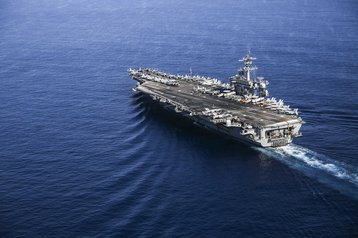The US Navy has conducted a pilot project to see if users at sea can connect to cloud services.
On board the U.S.S. Abraham Lincoln, a Navy aircraft carrier, the project has demonstrated that the Navy can consistently move several terabytes of data each day between the cloud and thousands of users.
As reported by Federal News Network, the project is called Flank Speed Edge and is an extension of Frank Speed which is the Navy's Broader cloud environment.
The connectivity has been enabled by Proliferated Low Earth Orbit (P-LEO) satellite services - constellations of satellite services that form mesh networks via optical links.
In the pilot project, the Navy installed a gigabit of satellite connectivity on the U.S.S. Abraham Lincoln. The Navy is currently able to transfer between three and five terabytes of data per day.
“I’ve seen a tremendous value from this afloat. All of the staff are using their Flank Speed capabilities to maintain continuity,” said Navy CIO Commander Kevin White during a live video demonstration from the Pacific Ocean.
“They’re using their NMCI (Navy/Marine Corps Intranet) phones to call home over voice over IP, or to call the beach to say, ‘Hey, I need this part rushed to the ship.’ We’re using it across all of our departments and embarked commands for quality-of-work type areas. Everything from our training department — ensuring that all of our readiness in our training cycle is up to date — to our medical department, to our supply department, they’re all reaching out over websites and services to ensure that we have continuity of operations, and ensure that this ship is ready to go when the time comes that we have to turn these services off.”
The entire satellite and WiFi infrastructure system has been managed by just three full-time sailors.
The deployment has also enabled the Navy to do software upgrades and updates across other parts of the ship without having to connect to a pier with a physical network connection.
“While we’re out at sea right now, with this P-LEO capability, a cloud-connected node, and all the right elements in place, we’re able to scale new capabilities as they become available and rapidly deploy them while they’re monitored from the shore side,” added Commander White.
While a successful project, White noted that sometimes the high-speed data links have to be shut down for operational reasons as the P-LEO can only handle unclassified data.
The infrastructure has been designed to be able to use a variety of connectivity mechanisms, including the military's SATCOM, and Starlink.
The Navy is also deploying Flank Speed Edge at shore-based hard-to-connect locations, including the service's 5th Fleet headquarters in Bahrain.
During the recent earnings call from Oracle, CTO and chairman Larry Ellison raised the possibility of putting small Oracle data centers in a ship or submarine.
Ellison explained that the company is soon looking at having a full Oracle Cloud in just six standard half racks that can go into virtually any data center, with every service in the cloud - including on a ship or in a submarine.
Ellison elaborated: "No one else can do it. We can put them on ships and on submarines. No one else can do it because we can start very, very small. All Oracle Clouds are identical, except for scale.
"All Oracle Clouds have all Oracle services and, because they're identical, they're fully automated. So, one of the reasons we took a little bit longer to get our cloud out was because we built something quite different than what our competitors have, and that allows us to go from very small to very large using the same automation software."







